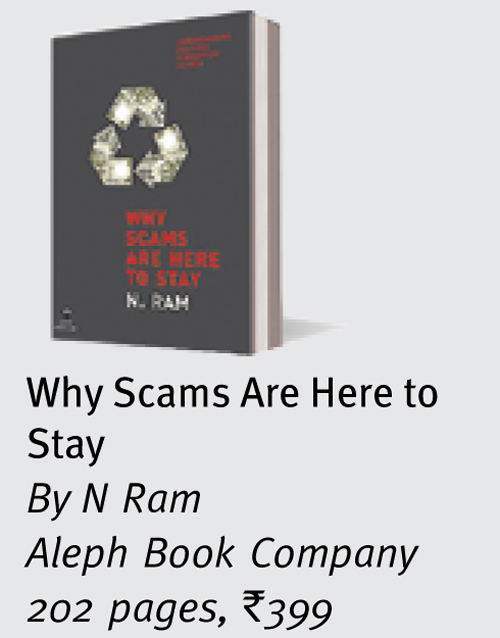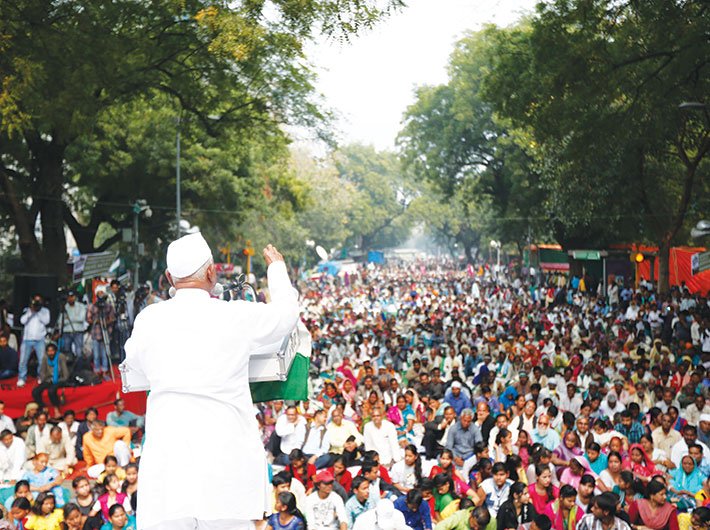Heavily sweetened dirty deals have always raised a stink and there is no end to insatiable greed.
The problem in this country is that the morbid stench of corruption is no longer overpowering. We seem to be putting the handkerchief to our nose and moving on, as if this is the new normal.
N Ram, chairman of Kasturi & Sons Limited and former editor-in-chief of The Hindu and Frontline magazine, delves deep into the intractable corruption problem in his new book: ‘Why Scams Are Here to Stay’. It attempts to help the reader understand corruption in India and it does cover a lot of ground.
The book says that corruption dates back to the days of the East India Company and adds that it was shaped by its senior officials and its ‘nabobs’, who, returning home with huge fortunes, became a byword for the ‘new corruption’ in eighteenth century Britain. “East India Company officials were the major perpetrators of corruption in India but the colonial narrative made it appear that was an endemically corrupt society that had ensnared them in its coils,” Ram notes.
“In an infamous defence of his venality, Robert Clive, the founder of British imperium in India, gave expression in 1772 to the view that it was impossible to avoid the giving and receiving of costly ‘presents’ in the country. In a private letter written to a Tory politician, the East India Company’s third governor general, Charles Cornwallis, confided that he ‘really’ believed ‘every native of Hindostan’ to be corrupt,” it adds.
After India gained independence, there have been some efforts to get the measure of corruption. The first serious attempt was by the K Santhanam Committee, which was tasked in 1962 to “review the problem of corruption and make suggestions”. It had the following to say: “The problem of corruption is complex, having roots and ramifications in society as a whole. In its widest connotation, corruption includes improper or selfish exercise of power and influence attached to a public office or to the special position one occupies in public life. In this sense, the problem would have to be viewed in relation to the entire system of moral values and socio-economic structure of society which we could not undertake.”
According to Ram, the problem in India, “where moralistic approaches to corruption are common and often dominate public discourse, is that the gap between what the anti-corruption campaigners, many of them ‘Gandhians’, demand and what the polity and the legal system are willing and able to do, is enormous.”
The result, he argues, is that “anti-corruption institutional arrangements and actions habitually miss the mark; and mass campaigns against corruption, fuelled largely by moral outrage, make their contribution by raising the level of public awareness but are unable to sustain themselves beyond a point and fail to meet the lofty objectives they set themselves.” The anti-corruption movements spearheaded by Jayaprakash Narayan in the 1970s and by Anna Hazare in 2011-12 make the point.
To an oft repeated argument on corruption, the book notes that there was a time when the stock explanation for corruption in India was the ‘permit-licence-quota raj’ – virtually everything could be attributed to it. “The prediction offered by a legion of neoliberal economists and political theorists was that deregulation and liberalisation would lead to the prevention, containment, and eventual elimination of corruption.” Precisely the opposite has happened: liberalisation has ushered in corruption in a much larger variety of forms than anything seen under the so-called licence raj. Not to forget, crony capitalism.
Taking a critical look at electoral finance, the author says it typically involves corruption on a large scale. “But the variability of national laws regulating campaign financing and donations to political parties and the seriousness with which they are enforced can make a significant difference to the incidence, forms and scale of this type of corruption.”
So, how much of an actual advance does the Lokpal as an institution, represent?
Ram refers to an emailed response from NS Nigam, associate professor at the Azim Premji University in Bengaluru, who explained why the Lokpal could not possibly be a deep cure for corruption in India: “its proposed strength is its independence from the political corruption that it is supposed to investigate.
However, even the most independent of investigative agencies cannot adjudicate the guilt of persons accused of corruption. An investigating body cannot establish conclusively that a person is involved in political corruption; in a democracy this function is performed by the judiciary alone. If the judicial process is delayed or compromised in adjudicating on corruption, the Lokpal’s efforts will necessarily fail to bear fruition.”
Is India more corrupt that most other countries? To that, the book says, when it comes to comparisons, there is an easy case and a virtually insoluble one. What we can say with certainty or near certainty, based on our general knowledge and experience, is that there is far more corruption in India than in Denmark or the UK or Germany or Singapore. This is a subjective, qualitative judgement that is easy to form and it is unlikely to be contested seriously.
But, is there more corruption in India than in China or South Africa or Brazil or Nigeria?
The author says, “we cannot answer this question because there is no reliable empirical basis on which quantitative comparisons of corruption can be made, and qualitative judgements can be no more than guesses.”
The book goes on to say that there are sectors such as mining and, most notoriously the arms trade, where many foreign companies trying to do business with India engage in corruption, almost always through intermediaries or middlemen. “Disguising bribes and kickback as commissions and routing them through agents to decision-makers seems to the rule rather than the exception.”
In the section devoted to case studies, Ram discusses at length the Bofors scandal and corruption in Tamil Nadu. Notably, he had led The Hindu’s investigation in the Bofors case. The Bofors scandal revolved around the Rajiv Gandhi government’s decision to purchase from the Swedish arms manufacturing company an advanced 155mm howitzer system. The transaction was valued at SEK 8.41 billion (Rs 1,437.72 crore at the prevailing exchange rate). “It turned out that unacknowledged payments aggregating Rs 64 crore – termed commissions and calculated on a percentage basis – had been paid by Bofors into secret Swiss bank accounts after the contract was won on March 24, 1986.”

An interesting anecdote shared by Ram is that when strenuous damage limitation and cover-up efforts were underway in India and Sweden, a tip came from unexpected quarters. “During the course of an informal conversation at the Rashtrapati Bhavan in 1988, R Venkataraman, president of India who had held various key ministerial portfolios including defence, and was known for his integrity, said to me, ‘Don’t you know that the standard rate of commission in major defence deals is 6 percent?’ ”
The book mentions the deadly corruption system in BJP-ruled Madhya Pradesh’s ‘Vyapam’, which involved a set of ingeniously devised criminal services provided on a rate-card basis, by the racketeers to students and job-seekers to cheat their way into state-run medical colleges and government jobs. The book should have, but does not go deeper into the Vyapam scam.
The author describes Tamil Nadu as a case of grand corruption. “It has specified rates for facilitative, collusive and extractive corruption, depending on the sector; fixed collection quotas, sweetened with incentives, for ministers, bureaucrats, and other collection agents; and no-nonsense enforcement of the rules.”
Ram suggests some remedial measures to tackle the deep-rooted malaise of corruption. He calls for action on the legislative front, including notifying without delay the Whistleblowers Protection Act. Action has also been sought on the need to overcome the lack of enforcement capacity. The author also stresses upon the need for stricter, cleaner and more effective regulation, besides raising the visibility of corporate and private sector fraud. An important suggestion is for reforming and cleansing political finance and electoral funding.
The book will be of considerable interest to researchers and academics, but for the average reader, it could be a clunky read in some parts. The narrative could have been much better handled. The section on case studies could have been more expansive since there is a lot of material in public domain, on a string of scams that have rocked this country over the past few decades.
rahul@governancenow.com
(The review appears in the August 1-15, 2017 issue of Governance Now)

